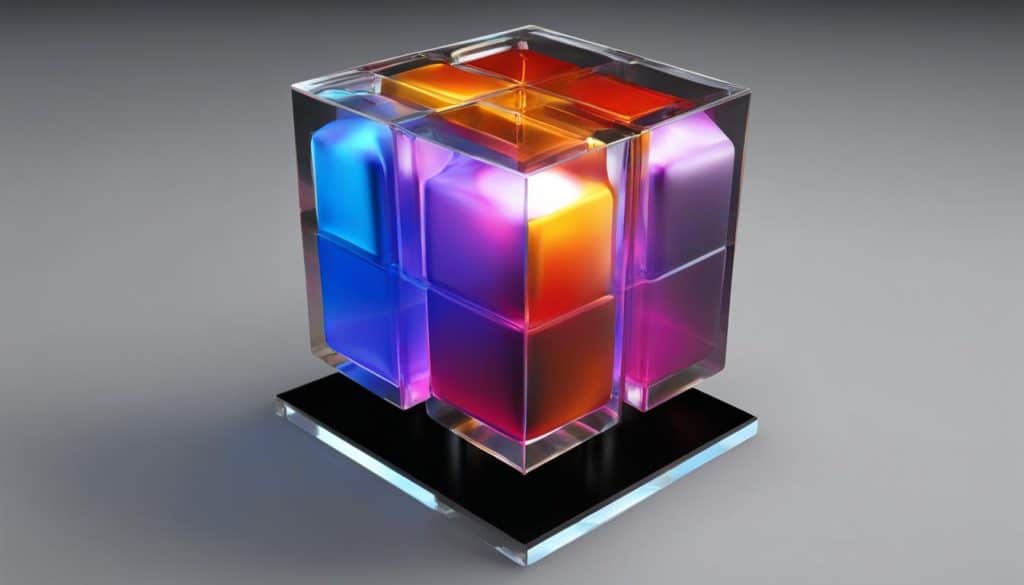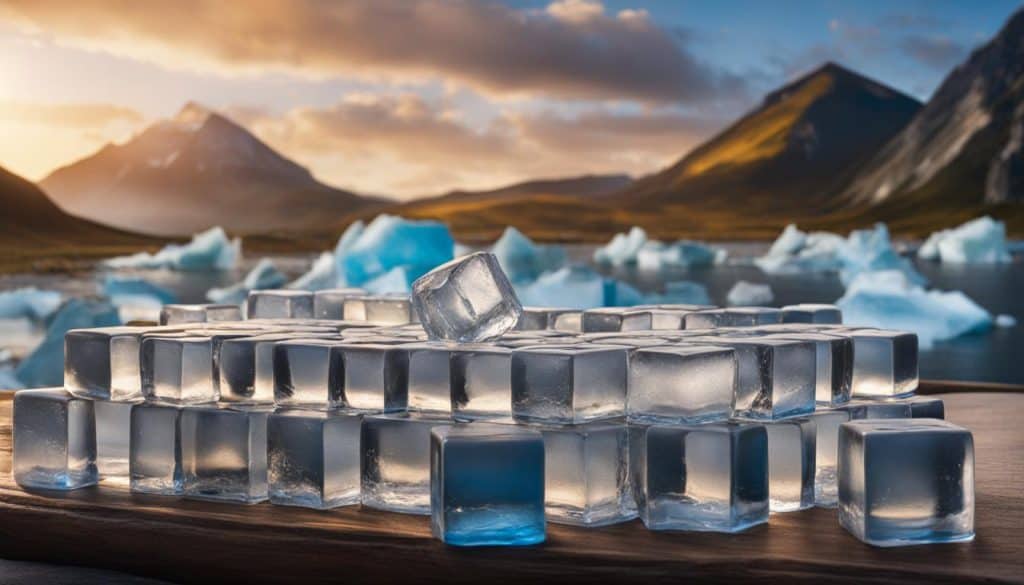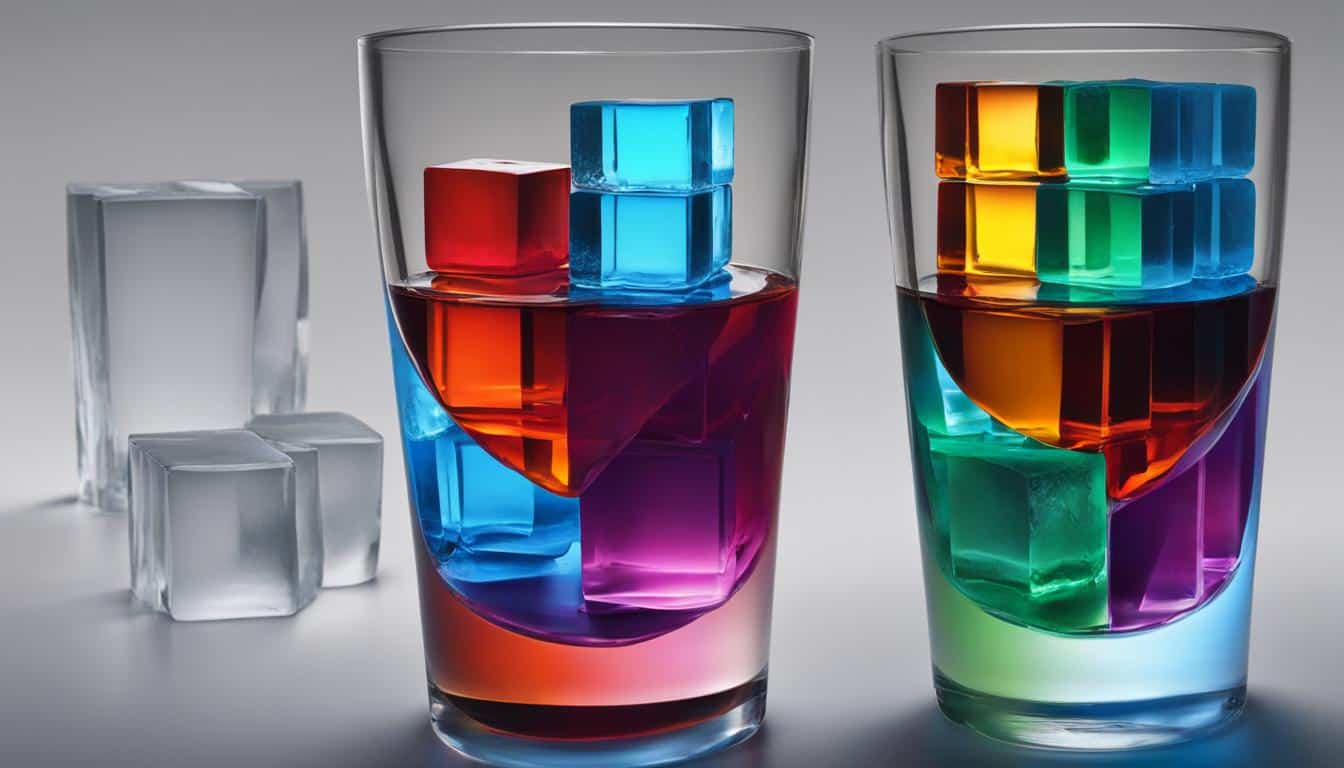Have you ever wondered why some ice cubes melt faster than others? The answer lies in the science behind the melt rates of full and half cubes, which we will explore in this article.
From understanding the science of ice to examining the factors that influence full vs. half cubes, we’ll provide you with all the information you need to make the perfect ice for your next drink.
But first, let’s take a look at some of the factors that affect the melting rates of ice cubes:
Surface Area Showdown: The Battle for Melting Supremacy
The surface area of ice cubes plays a critical role in determining their melting rates. When it comes to full cubes versus half cubes, the smaller size of half cubes gives them a higher surface-to-volume ratio and therefore a larger surface area. This increased surface area leads to faster heat transfer and, consequently, faster melting.
In other words…
The increased surface area in half cubes provides a faster path for heat to transfer from the surrounding liquid to the ice, causing it to melt quicker than full cubes.
This means that if you prefer your drink on the rocks, using half cubes will quickly provide the chill you desire. However, if you prefer a drink that stays cold and less diluted, full cubes may be the better option.
In the table below, we can see a comparison of the surface area and volume of full and half cubes, as well as the resulting surface-to-volume ratio:
| Type of Cube | Surface Area (in²) | Volume (in³) | Surface-to-Volume Ratio |
|---|---|---|---|
| Full Cube | 6 | 8 | 0.75 |
| Half Cube | 4.5 | 4 | 1.125 |
As you can see, the surface-to-volume ratio of half cubes is higher than that of full cubes, resulting in a larger surface area that allows them to melt faster.
Now that we understand the importance of surface area in determining melting rates, we can explore how thermal mass also plays a crucial role in the full versus half cube debate.
Thermal Mass Mania: The Role of Heat Sink Capacity
Besides surface area, another crucial factor that affects the melting rates of full and half ice cubes is thermal mass. Full cubes, with their greater mass, have a higher “heat sink” capacity, meaning they can absorb more heat before they start melting.
This can delay the melting process and keep your drink colder for longer. On the other hand, half cubes with their lower thermal mass, melt faster and tend to water down drinks quickly.
Understanding the concept of thermal mass is key to appreciating the differences between full and half cubes. Thermal mass refers to an object’s ability to store heat, which is determined by its mass, specific heat capacity, and temperature difference.
Full cubes, with their higher mass, absorp more heat before their temperature rises, keeping the ice colder for longer. In contrast, half cubes with their lower mass start melting faster, which can dilute drinks excessively.
One way to understand the impact of thermal mass on melting rates is to conduct an experiment. In a controlled environment, place a full ice cube and a half ice cube on separate plates at room temperature.
Over time, observe the melting rates and record the results. You will notice that the full ice cube takes longer to melt than the half ice cube due to its higher heat sink capacity.

Thermal mass has other applications besides ice cubes. It plays an important role in building design, where materials with high thermal mass, like concrete and brick, can absorb and store heat more efficiently, leading to lower energy consumption.
Understanding the concept of thermal mass can help you appreciate the science behind ice cube makers and make a more informed decision when choosing between full and half cubes.
The Race to the Core: Inner Core vs. Outer Layers
As the ice cubes begin to melt in your drink, the surface area decreases, slowing down the melting process. However, the full cube has an advantage over the half cube.
It retains its inner core of cold ice for a longer period compared to the half cube. This is because the outer layers of the cube melt first, which creates a slow “race to the core.”
Due to its larger size and thermal mass, the full cube has a slower melting process overall. As the outer layers of the cube gradually melt, the inner core remains cold for longer, chilling your drink without adding as much water.
This means that the full cube is ideal for cocktails and spirits, where quick dilution is undesirable.

| Full Cube | Half Cube | |
|---|---|---|
| Time to melt completely | 2 hours | 1.5 hours |
| Time for outer layer to melt | 30 minutes | 15 minutes |
| Time for inner core to melt | 1.5 hours | 1 hour |
As you can see from the table, while the full cube may take longer to melt entirely, it retains its inner core of cold ice for a significantly longer period compared to the half cube.
Overall, the key difference between full and half ice cubes lies in their melting rates. While half cubes melt faster due to their smaller size and increased surface area, full cubes retain their inner core of cold ice for longer, ideal for drinks where dilution is unwanted.
Shape Matters: The Impact of Ice Cube Shape
When it comes to ice cubes, shape matters. While the shape is not the main factor, it can affect the melting rates of ice cubes depending on their size and structure. Rounded shapes like spheres minimize surface area compared to cubes, potentially delaying melting slightly.
On the other hand, crescent shapes, with their larger exposed surface area, might melt slightly faster than cubes.
The shape of the ice cubes can also depend on their intended use. For example, bullet-shaped ice cubes are popular in certain drinks, such as iced coffee or whiskey, due to their slower melting rates, which help to preserve the flavor of the beverage.
To understand the impact of shape on melting rates, let’s take a look at a table that compares some common ice cube shapes:
| Ice Cube Shape | Surface Area | Melting Rate |
|---|---|---|
| Cube | Low | Medium |
| Half Cube | High | Fast |
| Sphere | Low | Slow |
| Crescent | High | Slightly Faster than Cube |
The data shows that rounded shapes like spheres have a lower surface area and melt slower than traditional cubes. Meanwhile, crescent shapes and half cubes have a higher surface area and tend to melt faster.
In the full vs. half cube debate, while it might seem like full cubes would last longer, their shape can also play a role in how quickly they melt. Ultimately, when choosing the best ice cube shape, it’s a matter of personal preference and intended use.
Beyond the Basics: Additional Factors Influencing Melting Rates
While surface area and thermal mass are the two primary factors affecting ice cube melting rates, other factors can also come into play. Understanding these additional factors will help you customize your ice preparation for the perfect drink. Consider the following:
Water Temperature
The temperature of the water that you use to make your ice cubes can affect how the cubes melt. Warmer water will generally create ice that melts faster than colder water.
For optimal results, use water that’s just below room temperature when filling your ice tray. This will produce long-lasting ice cubes that won’t quickly dilute your drink.
Alcohol Content
Addition of alcohol to your drink decreases its freezing point, which affects the melting rate of the ice cubes.
If you’re making drinks with alcohol, you may want to consider making ice cubes with less water and more alcohol. This way, the ice will melt more slowly and you’ll avoid oversaturating your drink.
Pressure Changes
Higher altitudes can affect atmospheric pressure, which can impact the freezing and melting points of liquids. This is because lower air pressure results in lower boiling and freezing points for liquids.
As a result, ice cubes made at high altitudes may melt more quickly than those made at sea level. If you’re making ice cubes at a high altitude, consider using colder water to help counteract this effect.
Factors Affecting Ice Cube Melting Rates
| Factor | Impact |
|---|---|
| Surface Area | Smaller cubes melt faster due to higher surface-to-volume ratio. |
| Thermal Mass | Larger cubes have greater heat sink capacity and can absorb more heat before melting. |
| Water Temperature | Warmer water produces ice cubes that melt more quickly. |
| Alcohol Content | Alcohol lowers the freezing point of liquids, affecting melting rates. |
| Pressure Changes | Higher altitudes can cause ice to melt more quickly due to lower freezing points. |
As you can see, melting rates are influenced by various factors, each playing a part in creating the perfect cocktail. By understanding these factors, you’ll be able to create ice cubes that cater to your personal taste preferences.
Impact on Your Drink: Dilution vs. Quick Chill
Now that we’ve explored the science behind full vs. half ice cubes, let’s talk about how each type can impact your drink. When it comes to dilution, full cubes have the advantage of melting slower, resulting in less water in your drink and a more concentrated flavor.
However, if you’re in a hurry and want a quick chill, half cubes are the way to go. They melt faster, cooling your drink more rapidly.
But keep in mind that the quicker the cube melts, the more water it will contribute to your drink. This means that if you prefer a stronger, less diluted drink, full cubes might be the better option for you.
On the other hand, if you don’t mind a slightly more diluted drink and want it chilled right away, half cubes might be the way to go.
Ultimately, the choice comes down to personal preference and what you’re looking for in your drink. Are you a purist who wants a strong, unadulterated flavor? Then full cubes might be your best bet. Do you prioritize a refreshing, chilled drink above all else? Half cubes are the way to go.
Regardless of which type of cube you choose, it’s important to understand the impact it can have on your drink. By making an informed decision, you can ensure that your drink is just the way you like it.


